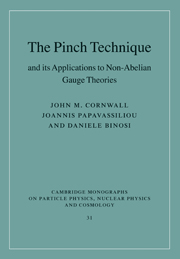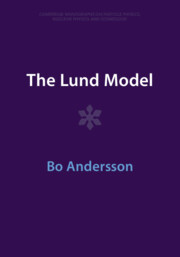The Pinch Technique and its Applications to Non-Abelian Gauge Theories
Part of Cambridge Monographs on Particle Physics, Nuclear Physics and Cosmology
- Authors:
- John M. Cornwall, University of California, Los Angeles
- Joannis Papavassiliou, Universitat de València, Spain
- Daniele Binosi, European Centre for Theoretical Studies in Nuclear Physics and Related Areas (ECT)
- Date Published: July 2023
- availability: Available
- format: Paperback
- isbn: 9781009402439
Paperback
Other available formats:
Hardback
Looking for an inspection copy?
Please email [email protected] to enquire about an inspection copy of this book
-
Non-Abelian gauge theories, such as quantum chromodynamics (QCD) or electroweak theory, are best studied with the aid of Green's functions that are gauge-invariant off-shell, but unlike for the photon in quantum electrodynamics, conventional graphical constructions fail. The pinch technique provides a systematic framework for constructing such Green's functions, and has many useful applications. Beginning with elementary one-loop examples, this book goes on to extend the method to all orders, showing that the pinch technique is equivalent to calculations in the background field Feynman gauge. The Schwinger–Dyson equations are derived within the pinch technique framework, and are used to show how a dynamical gluon mass arises in QCD. Finally the volume turns to its many applications. This book is ideal for elementary particle theorists and graduate students. This 2011 title has been reissued as an Open Access publication on Cambridge Core.
Read more- A comprehensive treatment of the pinch technique for non-Abelian gauge theories
- Shows how to preserve local gauge invariance in constructing off-shell Green's functions of non-Abelian gauge theories
- Covers in detail many applications to quantum chromodynamics (QCD), electroweak theory, and even supersymmetric gauge theories
- Reissued as an Open Access title on Cambridge Core
Customer reviews
Not yet reviewed
Be the first to review
Review was not posted due to profanity
×Product details
- Date Published: July 2023
- format: Paperback
- isbn: 9781009402439
- length: 306 pages
- dimensions: 244 x 169 x 16 mm
- weight: 0.54kg
- availability: Available
Table of Contents
Introduction
1. The pinch technique at one loop
2. Advanced pinch technique – still one loop
3. Pinch technique to all orders
4. The pinch technique in the Batalin–Vilkovisky framework
5. The gauge technique
6. Schwinger–Dyson equations in the pinch technique framework
7. Non-perturbative gluon mass and quantum solitons
8. Nexuses, sphalerons, and fractional topological charge
9. A brief summary of d=3 NAGTs
10. The pinch technique for electroweak theory
11. Other applications of the pinch technique
Appendix
Index.
Sorry, this resource is locked
Please register or sign in to request access. If you are having problems accessing these resources please email [email protected]
Register Sign in» Proceed
You are now leaving the Cambridge University Press website. Your eBook purchase and download will be completed by our partner www.ebooks.com. Please see the permission section of the www.ebooks.com catalogue page for details of the print & copy limits on our eBooks.
Continue ×Are you sure you want to delete your account?
This cannot be undone.
Thank you for your feedback which will help us improve our service.
If you requested a response, we will make sure to get back to you shortly.
×








